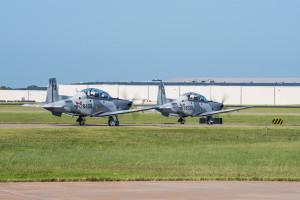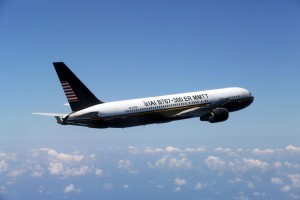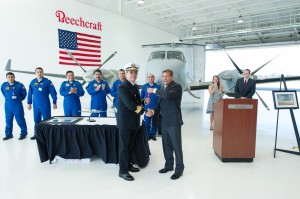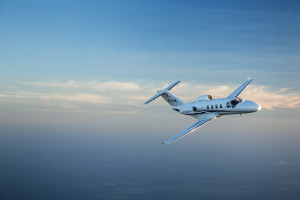Aeromexico Becomes First Airline to Commit to Gogo’s Next Generation In-flight Connectivity Technology – 2Ku
August 26, 2014
ITASCA, Ill., Aug. 26, 2014 /PRNewswire/ — Gogo (NASDAQ: GOGO), a leading global aero-communications service provider, announced today that it has signed a definitive agreement with Aeromexico, Mexico’s global airline, to provide in-flight Internet and wireless in-flight entertainment service on at least 58 Embraer and Boeing 737 aircraft operated by Aeromexico. Gogo previously announced, in December 2013, that it had agreed on the principal terms and conditions with Aeromexico related to the service. As part of the definitive agreement, at least 20 of Aeromexico’s 737 aircraft will receive Gogo’s next generation in-flight connectivity solution – 2Ku. Aeromexico is the first airline to commit to 2Ku.
“We couldn’t be more excited to work with Aeromexico to bring Gogo connectivity and Gogo’s wireless in-flight entertainment solution – Gogo Vision – to Mexico and beyond,” said Gogo’s president and CEO, Michael Small. “Aeromexico’s commitment to 2Ku is evidence of the advantages that 2Ku brings to the market – especially for aircraft that operate in tropical regions around the world.”
The advantages of 2Ku are significant. Gogo believes that 2Ku is the fastest solution available in the marketplace and expects it to deliver peak speeds of more than 70 Mbps to the aircraft at launch and more than 100 Mbps to the aircraft when next generation satellites become available. The 2Ku antenna is two times more spectrally efficient than other antennas in the commercial aviation market, which makes it capable of providing more bandwidth at less cost.
2Ku’s performance benefits will be even more dramatic in the tropical regions of the globe where the performance of other satellite solutions degrade significantly due to restrictions associated with operating at high skew angles.
Gogo expects both its connectivity service and Gogo Vision to be available to Aeromexico passengers beginning in the fourth quarter of 2015.
“As the airline that connects Mexico and Mexico with the world, we look forward to being the first Mexican carrier and the first in Latin America to offer our passengers in-flight Wi-Fi via Gogo, the leader in this space,” said Aeromexico’s CEO, Andres Conesa. “The decision to deploy 2Ku is a natural fit for many of our 737 aircraft and it assures that our passengers will have the latest technology available at launch.”
Bell Helicopter Training Academy Receives CAAC Part 147 Approval Authorization is another key milestone in the facility’s global training strategy
August 26, 2014
FORT WORTH, TEXAS (August 26, 2014) – Bell Helicopter, a Textron Inc. company, (NYSE: TXT), announced the Bell Helicopter Training Academy (BTA) has received Part 147 facility organizational approval from the Civil Aviation Administration of China (CAAC).
This authorization allows the BTA to conduct theory and practical training in China for the Bell 206, Bell 407, Bell 412 and Bell 429 product lines. The certification covers maintenance and avionics theory and practical training for all approved aircraft.
“The Bell Helicopter Training Academy is known worldwide for its outstanding instructors and capabilities,” said Eric Cardinali, executive vice president of Bell Helicopter’s Customer Support and Services organization. “However, our customers are requesting that same service and expertise be offered regionally. The CAAC Part 147 authorization is an important step in our efforts to bring technical training to China.”
Bell Helicopter’s regional sales team, led by Chris Jaran, managing director, worked closely with members of the BTA to meet the CAAC audit requirements. The team also engaged members of the Guangzhou Civil Aviation College to increase their exposure to Bell Helicopter technical training practices. The college is currently working with Bell Helicopter to offer Bell Helicopter authorized technical training for the Bell 407 and Bell 206 product lines.
“The collaborative efforts of the BTA, our regional sales and marketing team and the Civil Aviation College served to ensure a successful certification process,” said Charles Fisher, director, Bell Helicopter Training Academy. “It’s another example of our continued focus on global growth and support to keep our customers safely flying.”
Successful test-flights for Israel Aerospace Industries’ B767 Tanker using an advanced Fly-by-Wire (FBW) boom system
August 26, 2014
August 26th, 2014– Israel Aerospace Industries (IAI) recently performed successful test-flights on a B767-300ER aircraft, equipped with an advanced Fly-by-Wire (FBW) boom system. The new added FBW boom capability, for this specific type of aircraft, joins and enhances the company’s extensive experience in converting tens of aircraft (B767, B707, C130, and IL-78) to tankers or multi mission tanker/transport (MMTT) platforms, for more than 12 customers worldwide, including the Israel Air Force (IAF).
�
IAI’s innovative concept is based on conversion of pre-owned 767 passenger aircraft .The low utilization rate of MMTT platforms compared to commercial passenger aircraft translates into a continued long-term service life at a considerably lower Life Cycle Cost than for new aircraft. As part of the conversion a major part of the structure, wiring and systems are replaced, upgraded or refurbished. New engines, new military avionics including a state-of-the-art glass cockpit and new self-protection systems can also be offered, tailored to the customer’s specific requirements. The operational and technological experience gained from IAF and IAI’s other customers has been taken into consideration and utilized in the design and development of the new generation B767-300ER MMTT.
�
An IAI B767-200ER MMTT has been converted for the Colombian Air Force (CAF) and is performing successfully in all CAF support missions which include: air-refueling, troop and cargo transport, and presidential (VIP) transport worldwide. From 2012-2013, the B767 MMTT performed successfully in the US Red Flag, Canadian Maple Flag and Brazilian Cruzex exercises.
�
IAI is currently also offering MMTT platforms based on converted B767-300ER. This version, with over 400,000 lbs MTOW, can carry over 200,000 lbs. of fuel, additional troops and extra cargo pallets. IAI is continuously looking at improving and upgrading its Tanker/Transport aircraft and can offer a “Smart Tanker” version which performs additional tasks while in the air, such as: ELINT, SIGINT, and ESM, or serve as a communications hub or as a Command & Control post.
In the picture: IAI’s Bedek Aviation Group’s B767 during a FBW boom system test-flight
Beechcraft delivers T-6C+ trainers, King Air 350ER to Mexican Navy
August 21, 2014
Navy Secretaría de Marina (SEMAR), as well as one King Air 350ER, the second of four on order, as part of the Mexican Navy’s ongoing fixed-wing aircraft modernization program.
“Being chosen by the Mexican Navy for this modernization program shows a superior level of confidence not only in Beechcraft products to fill its mission requirements, but in the product support we’ll provide as part of the agreement,” said Russ Bartlett, president, Beechcraft Defense Company. “This is a great example of how militaries around the globe can take advantage of the broad product range and support that Textron Aviation can provide to meet different requirements.”
Bartlett also lauded the cooperation between SEMAR officials and the company in moving so swiftly from the T-6C+ contract award in March to delivery this month.
The newly delivered King Air is part of a four-aircraft contract signed earlier this year. The first King Air 350ER was delivered just a few months ago, and the remaining aircraft are expected to be delivered by early 2015. In addition to the aircraft, both contracts with SEMAR include parts support as well as training for pilots and mechanics.
The T-6C+ features a hard-point wing, Heads-Up Display, Up-Front Control Panel, an integrated glass cockpit and an advanced Esterline CMC Cockpit 4000 avionics suite that greatly expands advanced training opportunities. The systems are integrated with a Hands-On Throttle and Stick (HOTAS), providing the student pilot and instructor with a simpler interface to the digital cockpit. The open architecture design of the Cockpit 4000 provides the flexibility to expand capabilities and continuously meet current and future training needs.
The Beechcraft T-6 military training fleet has surpassed 850 aircraft worldwide with more than 2.5 million flight hours. The T-6 military trainer offers military operators worldwide the most proven and cost-effective primary aviation training system available today. Aircraft deliveries began in 2000 after the T-6 was selected to fill the Joint Primary Aircraft Training System role for the U.S. Air Force and the U.S. Navy. Since then, additional military customers worldwide have selected the T-6, including the NATO Flying Training in Canada Program, the Hellenic Air Force of Greece, the Israeli Air Force, the Iraqi Air Force, the Royal Moroccan Air Force, the Royal New Zealand Air Force, the Mexican Air Force and the Mexican Navy.
King Air turboprops, which operate commercially and in all branches of the U.S. military, serve a variety of missions ranging from traditional passenger and cargo transport to electronic and imagery surveillance, air ambulance, airway calibration, photographic mapping, training and weather modification. The global fleet recently surpassed 60 million flight hours.

�
�
�
�
�
�
�
�
�
Russian Helicopters gives green light to Brazilian service centre
August 13, 2014
Moscow / 13 August 2014
Russian Helicopters, a subsidiary of Oboronprom, part of State Corporation Rostec, is showcasing key innovations in helicopter manufacturing at Oboronexpo 2014 and the Engineering Technologies 2014 international forum, taking place on 13-17 August in the Moscow region town of Zhukovsky. The company will focus at the events on how it is embedding digital technologies in its production processes, its experience of and future plans for improving energy efficiency and lean manufacturing, and its successes in re-equipping and upgrading its production capacities.
“The competitiveness of our helicopters directly depends on the innovative solutions that we are introducing today, particularly digital production technologies and energy efficiency,” said Russian Helicopters Deputy CEO for Production Andrey Shibitov. “We are working hard to modernise and upgrade our enterprises, and are effectively creating a new production platform.”
Russian Helicopters’ digital manufacturing policy aims to boost productivity by introducing digital technologies into design, pre-production and manufacturing processes, as well as after-sales support. The policy focuses in particular on replacing traditional paper-based versions as the master copies of technical documentation and moving to 3D digital models. Implementing this policy in full will help Russian Helicopters to optimise production processes and execute plans quickly, as well as increasing technological flexibility and as a result production quality.
Another important pillar of the company’s ongoing upgrade programme is lean manufacturing. This is a strategy to reduce energy and material losses from production processes to a minimum, through energy savings, recycling of secondary materials and by-products, and reducing warehousing, logistics and other indirect costs. In tandem with embedding lean manufacturing techniques, Russian Helicopters is also focusing on improving the environmental sustainability of its production processes.
Implementation of energy efficiency programmes is forecast to reduce the company’s energy consumption by 40% by 2020 compared to 2010.
Russian Helicopters’ upgrade and technical re-equipping programme is already producing significant results. In 2013 alone, Russian Helicopters enterprises brought online more than 800 new pieces of equipment and undertook more than 100 measures to improve environmental sustainability and workplace safety. Investments in production capacity in 2013 totalled RUB 8.3 billion, an increase of 8.5% on 2012.
Oboronexpo 2014 showcases the latest developments from the defence industry, including missiles and artillery weapons, armoured and military vehicles, unmanned multirole systems and communications technologies.
Engineering Technologies 2014 is a dedicated forum for leading companies from the sector to share their successes, talk about successful and effective solutions, and discover more about the experience of other producers. At the forum, Russian Helicopters plans to hold a number of business meetings and presentations.
AgustaWestland to Display Corporate AW109s at LABACE
August 13, 2014
Finmeccanica – AgustaWestland has announced that its presence at the 2014 Latin America Business Aviation Association exhibition will feature two light twin helicopters, a Power and a GrandNew, both customer helicopters configured for corporate and VIP passenger transportation.
A separate unveiling of the all-new AW169 VIP interior will take place during the week, allowing attendees to view modern interior configurations and high-tech entertainment options for more than 20 AW169s on order throughout Brazil and other South American countries.
The GrandNew offers a unique combination of elegance, high speed, passenger comfort and safety. With seats for the pilot and up to seven passengers and a cruise speed of 154 knots (285 km/h), the aircraft boasts a spacious passenger cabin tailored and finished to the highest levels of Italian craftsmanship.
Chosen by VIP and corporate operators for its high-end design coupled with competitive operating costs, the suitability of the aircraft across is shown through sales of over 150 AW109 Power and Grand/GrandNew series of aircraft throughout Latin America.
With a 65 percent share in the multiengine segment, Finmeccanica – AgustaWestland plays a leading role in the global VIP/corporate market and offers the largest and most modern range of dedicated products. In addition to the aircraft on display, the Company will showcase its wide range of customer support and training solutions for a growing South American fleet that exceeds 300 aircraft in operation.
The exhibition, taking place in Saõ Paolo, begins on August 12 and runs through August 14. For more information, visit Finmeccanica – AgustaWestland at LABACE Outdoor Exhibit 5108.
Cessna Citation M2 receives certifications in Brazil and Argentina, makes LABACE debut
August 12, 2014
SÃO PAULO, Brazil, Aug. 12, 2014– Cessna Aircraft Company, a subsidiary of Textron Aviation, a Textron Inc. (NYSE: TXT) company, announced today at the Latin American Business Aviation Conference & Exhibition that that Citation M2 – making its LABACE debut – has gained final certification from civil aviation authorities in Brazil and Argentina, paving the way for deliveries to begin.
Since its certification from the U.S. Federal Aviation Administration in December and European Aviation Safety Agency in June, 31 Citation M2s have been delivered to customers through the first half of this year.
“The market in Latin America has shown tremendous interest in the Citation M2 due to its competitive acquisition and operating costs, its airport performance and its advanced onboard systems,” said Robert Gibbs, vice president, International Sales.
The Citation M2 has a maximum cruise speed of 404 knots true airspeed (460 miles per hour) and a range of 1,580 nautical miles. It can operate at airports with runways as short as 3,210 feet and will climb to 41,000 feet in 24 minutes. The Citation M2 is certified for single-pilot operation with room for seven passengers and features two Williams FJ44 engines.
The Citation M2’s clean cockpit design features Cessna’s proprietary Intrinzic™ flight deck powered by Garmin G3000 avionics, with high-resolution multifunction displays and split-screen capability. Touch-screen interactivity comparable to a smartphone provides pilots with precise performance information they need in a logical, familiar user interface. From the cockpit divider aft through the rear lavatory, the main passenger cabin of the Citation M2 is 58 inches wide and 11 feet long with a 5-inch dropped aisle providing a cabin height of 57 inches. Eight large windows, roomy adjustable seats and intuitive controls highlight the all-new cabin.
This announcement is another demonstration of the company’s continued efforts to invest in products that meet the needs of global customers. New Citation products expected to come to market within the coming year include the recent certification of the Citation X+ and upcoming introductions of the Citation CJ3+ and Citation Latitude.
More than 6,600 Citations have been delivered to customers around the world since the first Cessna Citation business jet was put into service in 1972. Citations are the largest fleet of business jets in the world and have surpassed 30 million flight hours.
Cessna Citation Sovereign+ on track for first Brazilian deliveries in September
August 12, 2014
SÃO PAULO, Brazil, Aug. 12, 2014 – Cessna Aircraft Company, a subsidiary of Textron Aviation, a Textron Inc. (NYSE:TXT) company, said today at the annual Latin American Business Aviation Conference & Exhibition it expects certification soon for the Citation Sovereign+ by the Agência Nacional de Aviação Civil to pave the way for the first scheduled deliveries to Brazilian customers during the third quarter of 2014.
Following certification in December by the Federal Aviation Administration in the United States and in June by the European Aviation Safety Agency, the Sovereign+ has gained certification in Mexico, Argentina and Chile. Through the second quarter, Cessna has delivered 24 Sovereign+ aircraft.
“The Citation Sovereign+ has already gained attention in Latin America for its short-field performance and its range,” said Kriya Shortt, senior vice president, Sales and Marketing. “Customers in São Paulo or Buenos Aires can reach the whole of South America non-stop, while a large portion of the U.S. is one flight away for customers leaving Manaus or Caracas.
“One of the best attributes of the Sovereign+ for Latin America is its ability to operate from smaller airfields, with a take-off distance of 3,530 feet,” Shortt said.
Featuring winglets and the new Pratt & Whitney Canada PW306D engines providing 5907 pounds of thrust, the Citation Sovereign+ has a range of 3,188 nautical miles (5,904 km), a top speed of 460 knots (529 miles per hour) and a direct climb to 45,000 feet.
The new cockpit in the Sovereign+ is designed around the Cessna Intrinzic Flight Deck powered by Garmin G5000 avionics. An integrated, workload-reducing auto throttle system streamlines the pilots’ tasks. With Cessna’s Clairity cabin management system and redesigned interior options, the Sovereign+ features the longest and most comfortable cabin in its class with a max seating configuration for up to 12 passengers. The Clairity system allows passengers to remain connected in-flight through the integration of smartphones and tablets, along with an airborne Internet system.
Cessna is offering the Sovereign+ with a unique Sovereign Shield program covering all scheduled maintenance and parts costs for the aircraft’s first five years or 1,500 flight hours, practically eliminating maintenance-related direct operating costs and allowing owners to operate the Citation Sovereign+ for far less than other business jets in the midsize category.
In service since 2004, the Citation Sovereign has reached a fleet of 349 aircraft worldwide and amassed more than 802,000 flight hours.
Today’s news reflects the company’s focus on continued investment in general aviation’s most extensive product line up for customers around the world. New Citation products expected to come to market within the coming year include the recent certification of the Citation X+ and upcoming introductions of the Citation CJ3+ and Citation Latitude.
More than 6,600 Citations have been delivered to customers around the world since the first Cessna Citation business jet was put into service in 1972. Citations are the largest fleet of business jets in the world and have surpassed 30 million flight hours.
Bermuda accepts Vector SMS safety management system for Rockwell Collins’ ARINC Direct customers
August 12, 2014
SÃO PAULO, Brazil (August 12, 2014) – The Bermuda Department of Civil Aviation (DCA) has accepted the Vector Safety Management System (SMS), available to Rockwell Collins’ ARINC Direct customers, to comply with the country’s SMS mandate requiring foreign business aviation operators to have an SMS program in place, or to have started the SMS implementation process.
Bermuda is the first country in the world to issue this mandate, which also requires a SMS for flight departments that are based within the nation. The announcement was made today at the 2014 Latin American Business Aviation Conference & Exhibition in São Paulo, Brazil.
The Vector SMS program, provided through a strategic agreement with Polaris Aero, LLC, seamlessly integrates with the ARINC Direct flight operation service so that customers can easily implement all of the critical components of a safety management system.
This integration enables ARINC Direct Vector SMS users to identify risks and hazards which, once known, can be addressed via guidance or advisories that have a direct impact on safety. In addition, because Vector SMS is a web-based service, it is significantly easier to implement than paper-based programs.
“Safety Management Systems are becoming a standard throughout the aviation industry worldwide,” said Bob Richard, staff vice president, ARINC Direct for Rockwell Collins. “Our fully integrated Vector SMS program helps business aviation customers comply with not only Bermuda’s new mandates but also other countries’ as these standards become adopted globally and help drive improvements in aviation safety everywhere.”
Bell Helicopter Promotes Safety in Sao Paulo with Safety Symposium
August 12, 2014
Collaboration with regional safety experts and local authorities enriches customer experience
SAO PAULO, BRAZIL (August 12, 2014) – Bell Helicopter, a Textron Inc. company (NYSE: TXT), announced it held a regional Safety Symposium for rotorcraft pilots and technicians from across Brazil on Monday, August 11 at the Sao Paulo World Trade Center in Sao Paulo, Brazil.
Introduced in 2013, the safety symposium educates pilots and maintainers on key safety practices and applications to implement into their daily operations. The effort is tied, in part, to Bell Helicopter’s participation in the International Helicopter Safety Team’s (IHST) mission to establish international partnerships in countries with significant helicopter operations and encourage development of safety interventions.
Presenters included Bell Helicopter Training Academy pilots, local Bell Helicopter Customer Service Engineers, regional safety experts and local government representatives. The team introduced the concept of a Safety Management System – a holistic approach to managing safety in an organization by implementing the necessary organizational structure, metrics, accountability, policies and procedures. Human Factors Awareness training, a growing topic of interest with Bell Helicopter’s regional customers, was also presented. Air Force Lieutenant Colonel Aviator Sydney Velloso da Silva Junior, Chief 4th Regional District for the Investigation and Prevention of Aeronautical Accidents (CENIPA) welcomed the audience and spoke to the importance of such events to help increase the safety of flight. Army Lieutenant Colonel Paulo Queiro, IHST representative, Brazil, provided an update on the IHST’s progress towards improving rotorcraft safety worldwide.
“We were very pleased with the attendance at this event,” said Steve Woolston, director, Product Support for Bell Helicopter’s Customer Support and Services organization. “It‘s encouraging to see the message about the importance of safety being spread across the globe. Our collaboration with knowledgeable organizations such as the IHST, as well as the active participation and interest of the attendees, has allowed Bell Helicopter to make significant strides in our efforts to promote a culture of zero mishaps and zero accidents.”
More than 100 customers and safety advocates attended the event. An additional symposium is scheduled in Prague, Czech Republic on Sept. 17, to be held at the Bell Helicopter European Customization and Delivery Center.
<









